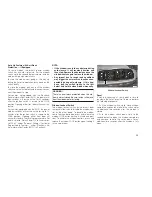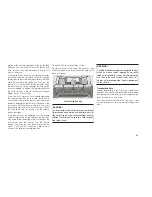
Here are some tips on getting the most out of
your child restraint:
•
Before buying any restraint system, make sure
that it has a label certifying that it meets all
applicable Safety Standards. The manufacturer
also recommends that you try a child restraint in
the vehicle seats where you will use it before
you buy it.
•
The restraint must be appropriate for your
child’s weight and height. Check the label on
the restraint for weight and height limits.
•
Carefully follow the instructions that come with
the restraint. If you install the restraint improp-
erly, it may not work when you need it.
•
Buckle the child into the restraint exactly as the
manufacturer’s instructions tell you.
•
When your child restraint is not in use, secure it
in the vehicle with the seat belt or remove it from
the vehicle. Do not leave it loose in the vehicle.
In a sudden stop or collision, it could strike the
occupants or seatbacks and cause serious
personal injury.
LATCH — Child Seat Anchorage System
(Lower Anchors and Tether for CHildren)
Your vehicle’s rear seat is equipped with the child
restraint anchorage system called LATCH. The
LATCH system provides for the installation of the
child restraint without using the vehicle’s seat
belts, instead securing the child restraint using
lower anchorages and upper tether straps from
the child restraint to the vehicle structure.
LATCH-compatible child restraint systems are
now available. However, because the lower an-
chorages are to be introduced over a period of
years, child restraint systems having attachments
for those anchorages will continue to have fea-
tures for installation using the vehicle’s seat belts.
Child restraints having tether straps and hooks for
connection to the top tether anchorages have
been available for some time. For some older
child restraints, many child restraint manufactur-
ers offer add-on tether strap kits or retro-fit kits.
You are urged to take advantage of all the avail-
able attachments provided with your child re-
straint in any vehicle.
The two outboard rear-seating positions have
lower anchorages that are capable of accommo-
dating LATCH-compatible child seats having flex-
ible, webbing-mounted lower attachments. Child
seats with fixed lower attachments must be in-
stalled in the outboard positions only. Regardless
of the specific type of lower attachment.
NEVER
install LATCH-compatible child seats such that
two seats share a common lower anchorage.
If you are installing LATCH-compatible child re-
straints in adjacent rear seating positions, you can
use the LATCH anchors or the vehicle’s seat belt
for the outboard position, but you must use the
vehicle’s seat belt at the center position. If your
child restraints are not LATCH-compatible, you
can only install the child restraints using the
vehicle’s seat belts. Please refer to “Installing the
LATCH-Compatible Child Restraint System” and
“Installing Child Restraints Using the Vehicle Seat
Belt” in this section for typical installation instruc-
tions.
37
Summary of Contents for Cherokee 2009
Page 1: ......
Page 2: ......
Page 3: ......
Page 5: ...2...
Page 9: ...6...
Page 11: ...8...
Page 15: ......
Page 45: ...42...
Page 50: ...Rear Window Defroster If Equipped 89 ROOF LUGGAGE RACK IF EQUIPPED 90 47...
Page 51: ......
Page 63: ...60...
Page 64: ...61...
Page 65: ...62...
Page 97: ...INSTRUMENT CLUSTER 94...
Page 106: ...Compass Variance Map 103...
Page 111: ...Compass Variance Map 108...
Page 116: ......
Page 120: ...117...
Page 123: ...Control Setting Suggestions for Various Weather Conditions 120...
Page 147: ......
Page 159: ......
Page 162: ......
Page 175: ...172...
Page 179: ......
Page 210: ...9 IF YOU NEED CONSUMER ASSISTANCE IF YOU NEED ASSISTANCE 208 207...
Page 212: ...209...
Page 213: ...210...
Page 214: ...10 INDEX 211...
















































